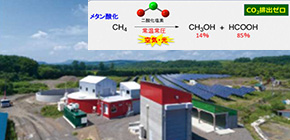
Commercial production of methanol using biogas obtained from animal manures
Osaka University concludes partnership agreement with Okoppe Town in Hokkaido regarding the development and commercialization of biogas oxidation technique
Osaka University and Okoppe Town in Hokkaido, the northernmost prefecture of Japan, concluded an agreement on the joint development of a technique for producing methanol from biogas and discussion of practical applications using technique for converting methane gas into methanol, a liquid fuel, and formic acid. This technique was developed by a group of researchers led by Professor OHKUBO Kei from the Osaka University Institute for Advanced Co-Creation Studies.
Okoppe Town runs Okoppe Hokko Biogas Plant, which can annually produce biogas of 540,000 cubic meters from manure of 560 farm animals. Methane (approximately 60% of biogas) produced at this plant is used for generating electric power. In addition to electric power selling, the plant had been looking for effective applications for the commercialization of biogas.
Under this agreement, the Okoppe Hokko Biogas Plant, the Okhotsk Research Center of Agriculture and Science, and the Osaka University Institute for Advanced Co-Creation Studies will jointly perform verification tests on the production of methanol and formic acid from methane gas found in biogas using the above-mentioned technique.
In addition, they will advance the development of techniques for converting methane gas from livestock manure into useful chemical intermediates under ambient conditions by using chlorine dioxide as an oxidizing agent.
Since methane is chemically stable, a very strong oxidizing agent is necessary for methane oxidation. However, because methanol, an intermediate in the oxidation of methane, is more easily oxidized than methane, this leads to the formation of further oxygenated products such as CO 2 and CO. For this reason, oxidization reactions from methane gas to methanol was very difficult to achieve.
Previously, the research group from Osaka University had found that methane could be nearly 100% converted into methanol and formic acid through CH4 oxygenation of CH3 (CH3 is generated under the photoirradiation of chlorine dioxide) in a fluorous solvent. This technique can be applied to methane gas in biogas. This agreement will lead to the production of industrially useful liquid fuels from biogas.
With this technique, the yields of methanol and formic acid were 14% and 85%, respectively, with a methane conversion of 99%. This technique is epoch-making in the development of aerobic oxidation from methane to methanol. The yield of oxygenated methane using this technique is on the top of the yield obtained by using other known oxidants.
This technique allows for easy conversion from valuable biogas resources to useful liquid fuels, which will become a critical step toward the solution of challenges in developing various oxidation reactions.
Figure 1
Figure 2
Figure 3
The article, "Light‐Driven C−H Oxygenation of Methane into Methanol and Formic Acid by Molecular Oxygen Using a Perfluorinated Solvent" was published in Angewandte Chemie at DOI: https://doi.org/ 10.1002/anie.201710945 .
Related links
- Ohkubo Group, Institute for Advanced Co-Creation Studies, Osaka University (link in Japanese)
